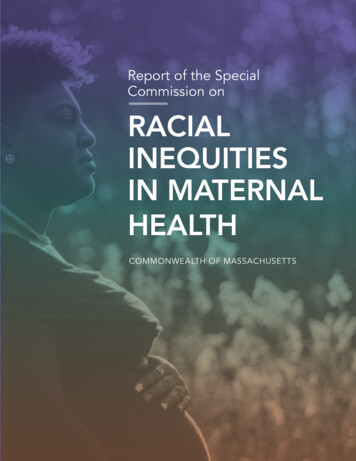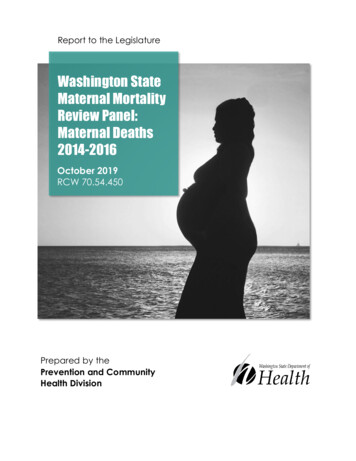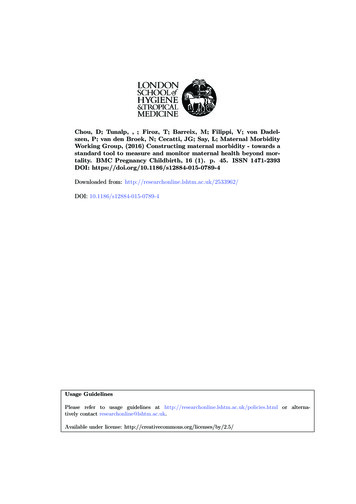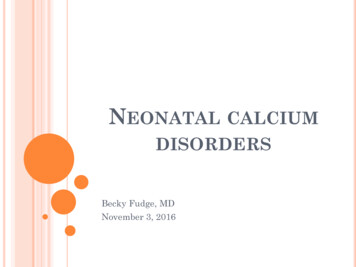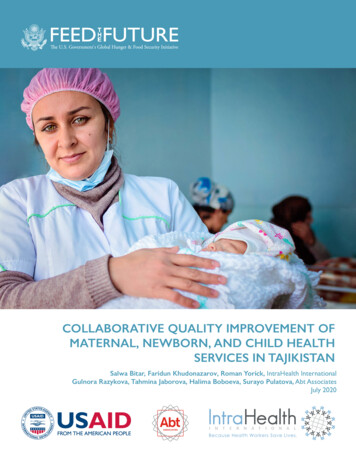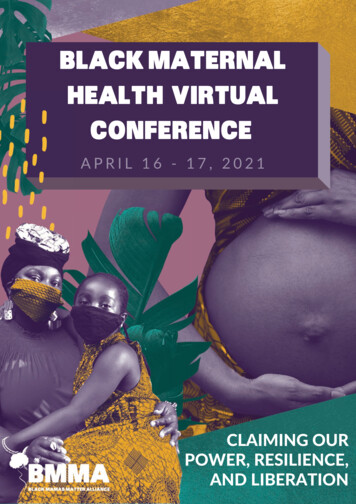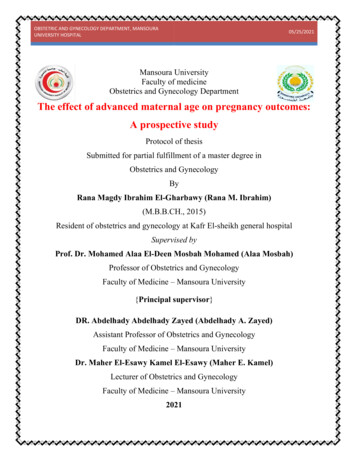
Transcription
OBSTETRIC AND GYNECOLOGY DEPARTMENT, MANSOURAUNIVERSITY HOSPITAL05/25/2021Mansoura UniversityFaculty of medicineObstetrics and Gynecology DepartmentThe effect of advanced maternal age on pregnancy outcomes:A prospective studyProtocol of thesisSubmitted for partial fulfillment of a master degree inObstetrics and GynecologyByRana Magdy Ibrahim El-Gharbawy (Rana M. Ibrahim)(M.B.B.CH., 2015)Resident of obstetrics and gynecology at Kafr El-sheikh general hospitalSupervised byProf. Dr. Mohamed Alaa El-Deen Mosbah Mohamed (Alaa Mosbah)Professor of Obstetrics and GynecologyFaculty of Medicine – Mansoura University{Principal supervisor}DR. Abdelhady Abdelhady Zayed (Abdelhady A. Zayed)Assistant Professor of Obstetrics and GynecologyFaculty of Medicine – Mansoura UniversityDr. Maher El-Esawy Kamel El-Esawy (Maher E. Kamel)Lecturer of Obstetrics and GynecologyFaculty of Medicine – Mansoura University2021
OBSTETRIC AND GYNECOLOGY DEPARTMENT, MANSOURAUNIVERSITY HOSPITAL05/25/2021IntroductionAdvanced maternal age (AMA) is mostly defined as a pregnancy in women 35 years of age or more during their pregnancy or time of delivery (1). It growstrending in high-income countries, which is most commonly seen in olderprimigravida women who delay child bearing by life style choice or due swomencontinuingchildbearing. Approximately 18% of all united states birth in 2018 were to womenwith advanced maternal age compare with approximately 5% before, much of thisshift due to delayed first births, the rate of first births increased seven-fold amongwomen aged 35 to 39 y and five-fold among women aged 40 to 44 y between 1985and 2018 (2).In England, the incidence of births to women aged 35y increased from 6% to20% at 2013. Pregnancy at advanced maternal age is associated with differentadverse neonatal outcomes. It is associated with stillbirth and also complicated byintrauterine fetal death (IUFD) and neonatal death (3 & 4). Advanced maternal age isreported to be associated with a range of pregnancy complications including: fetalgrowth restriction (FGR), preeclampsia (PE), placental abruption, pre-term birth(PTB) and stillbirth (5).Perinatal adverse outcomes like preterm birth, early neonatal death, low birthweight, neonatal intensive care unit (NICU) admission and APGAR score of less thanseven at five minutes are significantly associated with pregnancy at advancedmaternal age (6). The adverse outcomes result from inadequate cardiovascularadaptation during pregnancy, which impedes the hemodynamic changes forsupporting the fetus (7). This may explain occurrence of intrauterine growthrestriction and placental abruption at advanced maternal age (8).
OBSTETRIC AND GYNECOLOGY DEPARTMENT, MANSOURAUNIVERSITY HOSPITAL05/25/2021Early pregnancy outcomes associated with advanced maternal age include:Ectopic pregnancy which increase a four- to eight-fold in women more 35 yearsincreasing maternal mortality and morbidity (9). Epidemiological studies show anassociation between advanced maternal and paternal ages and the risk of autismspectrum disorders in the offspring, also advanced maternal age is a risk factor forcongenital malformation and Down syndrome (10).Risk of spontaneous abortion between 6 to 14 weeks of pregnancy increasedwith increasing maternal age (11). Late pregnancy outcomes including GestationalDM and preeclampsia which increasing up to 10% in women more 40 years of ageand higher up to 35% in women more than 50 years of age which may cause intrauterine growth retardation and stillbirth (12).Advanced maternal age is also linked to a higher prevalence of placentapraevia and placental abruption, both of which cause bleeding in late pregnancy (afterabout 20 weeks) especially in multipara (13). Women more than 40 years of ageshowed an eight-fold increased risk of amniotic fluid embolism due to increasedincidence of caesarian section and a three-fold increased risk of obstetric shockcompared with women age 25–29 years (14).According to the royal college of obstetricians and gynecologists, the optimumperiod for child bearing is between 20 and 35 years of age to decrease maternal andneonatal complications (15).
OBSTETRIC AND GYNECOLOGY DEPARTMENT, MANSOURAUNIVERSITY HOSPITAL05/25/2021Aim of workThis study to evaluate the effect of advanced maternal age on the outcomes ofpregnancy which include: maternal, obstetric, fetal and perinatal outcomes.
O B S T E T RI C A N D G Y N E C O L O G Y D E P A R T M E N T, M A N S O U R AU NI V E R SI T Y H O S PI T A L0 5/ 2 5/ 2 0 2 1P ati e nt a n d m et h o dsSt u d y D esi g n & A r e a: A pr os p e cti v e c o h ort st u d y of pr e g n a nt w o m e n r e cr uit e d fr o m D e p art m e nt ofO bst etri cs a n d G y n e c ol o g y, M a ns o ur a U ni v ersit y H os pit als d uri n g J u n e 2 0 2 1 u ntilJ u n e 2 0 2 2 a n d m a y b e e xt e n d e d if n e e d e d . T h e h os pit al o p er at es A nt e n at al cli ni cs si x h o urs e v er y d a y e x c e pt Fri d a y. M a ns o ur a U ni v ersit y H os pit al is R ef err al t e a c hi n g h os pit al, l o c at e d i n M a ns o ur a,E g y pt .St u d y p o p ul ati o n:T h e st u d y gr o u p will b e r e pr es e nt e d b y 5 0 pri mi gr a vi d a w o m e n a g e d 3 5 y orm or ed uri n g t h eir pr e g n a n c y a n d t h e c o ntr ol gr o u p will b e r e pr es e nt e d b y 5 0pri mi gr a vi d a w o m e n a g e d 2 0 -3 4 y d uri n g t h eir pr e g n a n c y till t h e ti m e of d eli v er y.A. I n cl usi o n c rit e ri a :- Pri mi gr a vi d a W o m e n wit h si n gl et o n pr e g n a n ci es a g e d 2 0 t o 3 4 y e ars i n c o ntr olgr o u p a n d a g e d 3 5 y or m or e i n c as e gr o u p, n at ur al c o n c e pti o n or wit h usi n g A R T,w h o s e e ki n g f or r o uti n e a nt e n at al c ar e t o t h e u ni v ersit y h os pit al a n d w h o will a c c e ptt h e st u d y pr ot o c ol.B. E x cl usi o n c rit e ri a :- P ati e nt s a g e d l ess t h a n 2 0 y will b e e x cl u d e d fr o m t h e st u d y .- P ati e nt s wit h m e di c al dis or d ers (a nti p h os p h oli pi d s y n dr o m e, c hr o ni c h y p ert e nsi o n,pr e -e xisti n g di a b et es, a ut oi m m u n e dis e as es, t hr o m b o-e m b oli c dis e as e).-Multi p ar a .
OBSTETRIC AND GYNECOLOGY DEPARTMENT, MANSOURAUNIVERSITY HOSPITAL05/25/2021Sample sizeSample size was calculated by PASS 15 Power Analysis and Sample SizeSoftware (2017). NCSS, LLC. Kaysville, Utah, USA, ncss.com/software/pass.Based on previous studies including Yogev et al. (2010), the authorshypothesize an overall poor outcome in 20% of young pregnant group vs. 60% inelderly pregnant group with a prevalence of elderly pregnant ladies of 25% vs. 75%of young pregnant ladies.A logistic regression of a binary response variable (Y) on a binary independentvariable (X) with a sample size (N) of 80 observations (of which 50% are in thegroup X 0 [40 young pregnant ladies] and 50% are in the group X 1 [40 elderlypregnant ladies]) achieves 94% power at a 0.050 significance level to detect a changein Prob (Y 1) from the baseline value of 0.200 to 0.600. This change corresponds toan odds ratio of 6.000.A two-sided Wald test is used.Considering a possible dropout rate (DR) of 20%, the expected number ofdropouts will be 20, and the dropout-inflated enrollment sample size (N') will be 100participants (50 young, and 50 elderly) where N' N / (1 – DR).- We will have 2 groups: the first group will be represented by 50 women aged 35 yor more and the second group will be represented by 50 women aged from 20 to 34y.- The first group will be also divided into 2 subgroups: group (1A) aged from 35yto 40 y, the group (1B) aged above 40 y and we will compare between the outcomesin the 2 groups which include maternal, obstetric, fetal and perinatal outcomes.- We will also compare between those with spontaneous pregnancy and those withART.
OBSTETRIC AND GYNECOLOGY DEPARTMENT, MANSOURAUNIVERSITY HOSPITAL05/25/2021All women in this study will be subjected to the following:I. History:a. Personal (age, duration of marriage, educational level, special habits).b. Menstrual: LMP to detect Gestational age expressed in weeks which calculatedfrom first day of LMP. For patients who underwent in vitro fertilization, gestationalage will be calculated from the date of the embryo transfer.c. Obstetric history: all patients will be primigravida.d. Past history: of any medical disease or surgical operation.e. Family history: of any hereditary or non-hereditary disease.c. Present history: of any symptoms during pregnancy, analysis of any complain,investigations will be done and treatment will be given during pregnancy.II. Clinical examination: General, abdominal and local examination.General examination: include blood pressure, pulse, temperature, height and weightto calculate body mass index (BMI) to determine maternal obesity.- Blood pressure to exclude the hypertensive patients. We will measure bloodpressure in each antenatal visit to diagnose the cases which may developgestational hypertension or preeclampsia after 20 weeks of gestations whichwill be screened and diagnosed clinically by the obstetricians, according toguidelines (16).Abdominal examination: include obstetric grips.Local examination: when indicated.
OBSTETRIC AND GYNECOLOGY DEPARTMENT, MANSOURAUNIVERSITY HOSPITAL05/25/2021III. Investigations:- All pregnant women will undergo routine investigations at the first antenatal visitwhich include: CBC, RH grouping, blood grouping, urine analysis, fasting andpostprandial blood glucose.-All pregnant women will be screened for gestational diabetes mellitus (GDM) with a50-g oral glucose challenge test between 24 and 28 weeks of gestation. Women withabnormal glucose challenge test (140 mg/dL) will undergo a 3-hour oral glucosetolerance test with a 100-g oral glucose load. The diagnosis of GDM will be madewhen levels of blood glucose are fasting plasma glucose above 95 mg/dL, 1 hourpostprandial above 130-140 mg/dL, and 2 hours postprandial above 120mg/dLaccording to The American College of Obstetricians and Gynecologists (ACOG)recommendations (17).- All pregnant women will undergo a monthly ultrasound examination until delivery.- All obstetrical and clinical data will be recorded and collected in an appropriatedatabase.-Obstetric outcomes will be recorded regarding pregnancy induced ia,antepartumhemorrhage,oligohydraminos or polyhydraminos, obtetretric shock and intrapartum hemorrhage.-Maternal outcomes will be recorded regarding mode of delivery “ceaserean orvaginal delivery”, premature rupture of membranes, preterm birth which is defined asdelivery of an infant before 37 weeks of gestation and will be classified into latepreterm (from 34 to less than 37 weeks of gestation) and early preterm birth (deliveryfrom 28 to 34 weeks of gestation), obstructed labor and prolonged labor.-Fetal outcomes will be recorded regarding congenital malformations, intrauterinegrowth restriction, intrauterine fetal death and stillbirth.
OBSTETRIC AND GYNECOLOGY DEPARTMENT, MANSOURAUNIVERSITY HOSPITAL05/25/2021- Perinatal outcomes will be recorded regarding birth weight which will be classifiedinto low birth weight (less than 2500 g), very low birth weight (less than 1500 g) andmacrosomia (more than 4000 g), birth asphyxia, meconium aspiration syndrome,NICU admission, neonatal hypoglycemia, Hyperbilirubinemia, 5-Min Apgar scoreless than 7 and neonatal death.Ethical Consideration- Agreement for this study will be obtained from the hospital's ethical committee.- Study protocol will be submitted for approval by IRB.- Informed consent will be obtained from pregnant women after adequate provisionof information regarding the study requirements and purpose.- Personal privacy will be respected in all levels of the study. Collected data will notbe used for any other purpose.Statistical analysisData will be entered and analyzed using IBM-SPSS software (IBM Corp. Released2017. IBM SPSS Statistics for Windows, Version 25.0. Armonk, NY: IBM Corp.)Qualitative data will be presented as Number and percent, Quantitative data will betested for normality using Shapiro-Wilk’s test then described as mean and standarddeviation for normally distributed data and median and range for non-normallydistributed. The appropriate statistical test will be applied according to data type withthe following suggested tests: Chi-Square for categorical variable.
OBSTETRIC AND GYNECOLOGY DEPARTMENT, MANSOURAUNIVERSITY HOSPITAL05/25/2021References1. Royal College of Obstetricians and Gynaecologists (RCOG). Induction oflabour at term in older mothers. Scientific impact.2013.Paper no. 34. London:RCOG.2. Blair O. Berger, MSPH Carrie Wolfson MPA Lawrence D. Reid, MPHDonna M. Strobino. Adverse Birth Outcomes Among Women of AdvancedMaternal Age With and Without Health Conditions in Maryland. Women'sHealth Issues (2021) Volume 31, Issue 1, , Pages 40-483. C. Lean, H. Derricott, R. L. Jones, and A. E. P. Heazell, Advancedmaternal age and adverse pregnancy outcomes: a systematic review andmeta-analysis”. PLoS One 2017, vol. 12, no. 10, Article ID e01862874. S. Arya, Z. D. Mulla, and S. K. Plavsic, “Outcomes of women delivering atvery advanced maternal age”Journal of Women’s Health, 2018, vol. 27, no. 11,pp. 1378–1384.5. Bhumi Sarvaiya, Birva Patel. Jay Soni, Kshyanaprava Behera, PravatiTripathy, Debjani Nayak, Pratibha Khosla. Pratik Kumar Lahiri,ASSOCIATED RISK AND PREGNANCY OUTCOMES IN ELDERLYPRIMIGRAVIDA MOTHERS. European Journal of Molecular & ClinicalMedicine, (2020) Volume 7, Issue 10, Pages 3780-37876. M. Laopaiboon, P. Lumbiganon, N. Intarut et al., “Advanced maternalage and pregnancy outcomes: a multicountry assessment”BJOG: AnInternational Journal of Obstetrics & Gynaecology. 2014, vol. 121, no. 1, pp. 49–56.
OBSTETRIC AND GYNECOLOGY DEPARTMENT, MANSOURAUNIVERSITY HOSPITAL05/25/20217. D. Shan, P. Y. Qiu, Y. X. Wu, Q. Chen, A. L. Li, and S. Ramadoss,“Pregnancy outcomes in women of advanced maternal age: a retrospectivecohort study from China”Scientific Reports, 2018, vol. 8, no. 1, p. 12239.8. Y. Wu, Y. Chen, M. Shen, Y. Guo, S. W. Wen, and A. Lanes “Adversematernal and neonatal outcomes among singleton pregnancies in women ofvery advanced maternal age: a retrospective cohort study.” BMC Pregnancyand Childbirth, 2019, vol. 19, no. 1, p. 3.9. Rosaly Correa-de-Araujo, Sung Sug (Sarah) Yoon. (Clinical Outcomes inHigh-Risk Pregnancies Due to Advanced Maternal Age), Journal of Women'sHealth. 2021, Vol. 30, No2. https://doi.org/10.1089/jwh.886010. Sandin S, Schendel D, Magnusson P, et al. Autism risk associated withparental age and with increasing difference in age between the parents. MolPsychiatry. 2016; 21: 693–70011.Magnus MC, Wilcox AJ, Morken NH, Weinberg CR, Ha- berg SE. Role ofmaternal age and pregnancy history in risk of miscarriage: Prospectiveregister-based study. BMJ.2019;364:l86912. Ericka M. Biagioni Linda E. May Nicholas T. Broskey. The impact ofadvanced maternal age on pregnancy and offspring health: A mechanisticrole for placental angiogenic growth mediators (2021) Volume 106, Pages 152113. Schmidt P, Skelly CL, Raines DA. Placental abruption (abruptioplacentae). Treasure Island, FL: StatPearls Publishing, 2020.14. Kaur K, Bhardwaj M, Kumar P, et al. Amniotic fluid embolism. JAnaesthesiol Clin Pharmacol. 2016; 32:153–159. Cross ref, Medline
OBSTETRIC AND GYNECOLOGY DEPARTMENT, MANSOURAUNIVERSITY HOSPITAL05/25/202115. J.-J. Sheen, J. D. Wright, D. Goffman et al., “Maternal age and risk foradverse outcomes,” American Journal of Obstetrics and Gynecology, 2018, vol.219, no. 4, pp. e1–390.16. psia.ACOG, 2019, vol. 13317. ACOG Practice Bulletin No. 190: Gestational Diabetes Mellitus. ObstetGynecol. 2018 Feb; 131 (2):e49-e64.
Faculty of Medicine - Mansoura University . 2021 . OBSTETRIC AND GYNECOLOGY DEPARTMENT, MANSOURA UNIVERSITY HOSPITAL 05/25/2021 Introduction Advanced maternal age (AMA) is mostly defined as a pregnancy in women 35 years of age or more during their pregnancy or time of delivery (1)It grows .


